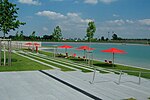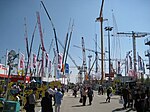Munich air disaster

The Munich air disaster occurred on 6 February 1958 when British European Airways Flight 609 crashed on its third attempt to take off from a slush-covered runway at Munich-Riem Airport in Munich, West Germany. The aircraft was carrying the Manchester United football team, nicknamed the "Busby Babes", along with supporters and journalists. There were 44 people on board, 20 of whom died at the scene. The injured, some unconscious, were taken to Munich's Rechts der Isar Hospital, where three more died, resulting in 23 fatalities with 21 survivors. The Manchester United team were returning from a European Cup match in Belgrade, Yugoslavia (now Serbia), having eliminated Red Star Belgrade to advance to the semi-finals of the competition. The flight stopped to refuel in Munich because a non-stop flight from Belgrade to Manchester was beyond the range of the "Elizabethan"-class Airspeed Ambassador. After refuelling, pilots James Thain and Kenneth Rayment twice abandoned take-off because of boost surging in the left engine. Fearing they would fall too far behind schedule, Thain rejected an overnight stay in Munich in favour of a third take-off attempt. By that time snow was falling, causing a layer of slush to form at the end of the runway. After hitting the slush, the aircraft ploughed through a fence beyond the end of the runway and the left wing was torn off when it struck a house. The tail section broke off and hit a barn with a parked fuel truck in it, which caught fire and exploded. Fearing the aircraft too might explode, Thain began evacuating passengers while goalkeeper Harry Gregg helped pull survivors from the wreckage. An investigation by West German airport authorities originally blamed Thain, saying he did not de-ice the aircraft's wings, despite eyewitness statements indicating that de-icing was unnecessary. It was later established that the crash was caused by the slush on the runway, which slowed the plane too much to enable take-off. Thain was cleared in 1968, ten years after the crash. United were aiming to become the third club to win three successive Football League titles; they were six points behind league leaders Wolverhampton Wanderers with 14 games still to play. They also held the FA Charity Shield and had just advanced into their second successive European Cup semi-finals. The team had not been beaten for 11 matches. The crash not only derailed the team's title ambitions that year but also destroyed the nucleus of what promised to be one of the greatest generations of players in English football history. It took ten years for the club to recover after the tragedy. Busby rebuilt the team and won the European Cup in 1968 with a new generation of "Babes".
Excerpt from the Wikipedia article Munich air disaster (License: CC BY-SA 3.0, Authors, Images).Munich air disaster
Emplstraße, Munich Trudering-Riem
Geographical coordinates (GPS) Address Nearby Places Show on map
Geographical coordinates (GPS)
| Latitude | Longitude |
|---|---|
| N 48.126111111111 ° | E 11.677777777778 ° |
Address
Emplstraße
Emplstraße
81829 Munich, Trudering-Riem
Bavaria, Germany
Open on Google Maps









